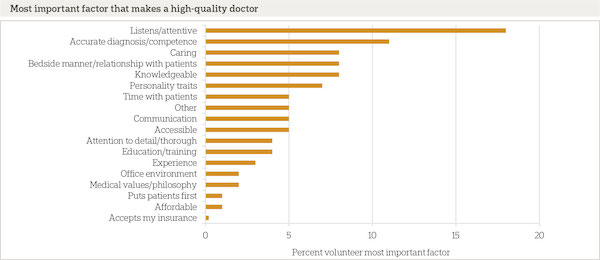Good Doc or Bad Doc: How Patients Judge Provider Quality
 There’s a troublesome disconnect between how the nation’s medical system defines the quality of healthcare providers and how patients and prospective patients judge a “good doctor.”
There’s a troublesome disconnect between how the nation’s medical system defines the quality of healthcare providers and how patients and prospective patients judge a “good doctor.”
“Doctors who listen are important, but ‘some of the nicest doctors are the least competent,’ cautioned Dr. Elliott Fisher of the Dartmouth Institute for Health Policy and Clinical Practice” in a recent Associate Press story.
“Most Americans focus on the doctor-patient relationship and interactions in the doctor’s office, with fewer thinking about the effectiveness of treatments or their own health outcomes."
In many respects, healthcare consumers are increasingly informed and involved in their medical decisions, due in part to access to hospital and physician evaluations. But “Americans do not think that information about the quality of health care providers is easy to come by, and they lack trust in information sources that tend to produce such indicators,” according to survey findings by the Associated Press-NORC Center for Public Affairs Research.
What makes a high-quality (or poor-quality) doctor?

In this survey, consumer responses tended to focus on doctor-patient relationships and personality (59 percent), versus delivery of care or outcomes (29 percent). The top responses say that a high-quality doctor:
- Listens, is attentive, or shows interest (in the patient) [18 percent];
- Has a caring attitude [8 percent];
- Has a good bedside manner [8 percent];
- Exhibits other positive personality traits [7 percent]; and
- Spends time with patients [5 percent].
And, what about the makings of a poor-quality doctor? In this study, Americans describe poor-quality doctors as:
- Those who do not listen or are inattentive [17 percent];
- Do not spend enough time with patients [10 percent], and
- Are overbooked or difficult to make appointments [9 percent].
“Doctors with bad personality traits [6 percent], poor bedside manner [5 percent], and those who are uncaring [5 percent] are also frequently mentioned as poor-quality. Nine percent mention a response related to health outcomes—that a poor-quality doctor is one who misdiagnoses or fails to fix their health problems.”
In our experience, it’s not surprising that most patients relate to doctor-patient interactions and personality traits first, because it’s an area where they have direct exposure. Coincidentally, they tend to expect effective care, and they have no means to judge clinical expertise.
Rating systems are poorly rated…
“Most people are not very confident they could find provider quality information they can trust on their own, including direct comparisons of physicians.” Instead, Americans say they “would trust word-of-mouth and personal recommendations from doctors far more than provider quality data coming from the government or third parties.
“Very few Americans say that high ratings on patient websites like HealthGrades.com, Yelp, or Angie’s List (26 percent) or being rated 'the best' by a local newspaper or magazine (15 percent) are extremely or very important to their decision-making process. In fact, nearly half (46 percent) say that each of these ratings systems is not too important or not important at all.
“Americans appear more interested in specific aspects of doctor or provider care. Two-thirds say that patients’ ratings of provider communication are an important factor.”
The detailed AP-NORC survey is recommended reading for providers and health care marketing professionals. Other findings and additional information, including the survey’s complete top-line findings, can be found on the AP-NORC Center’s website.
And for related reading, see our previous posts titled: New Era of Healthcare: Transparency, Candor and Pointed Questions and Transparency Fosters Physician Pride: It’s the Right Thing to Do.
See how Healthcare Success transforms doctor marketing by generating exposure and increasing qualified leads!








